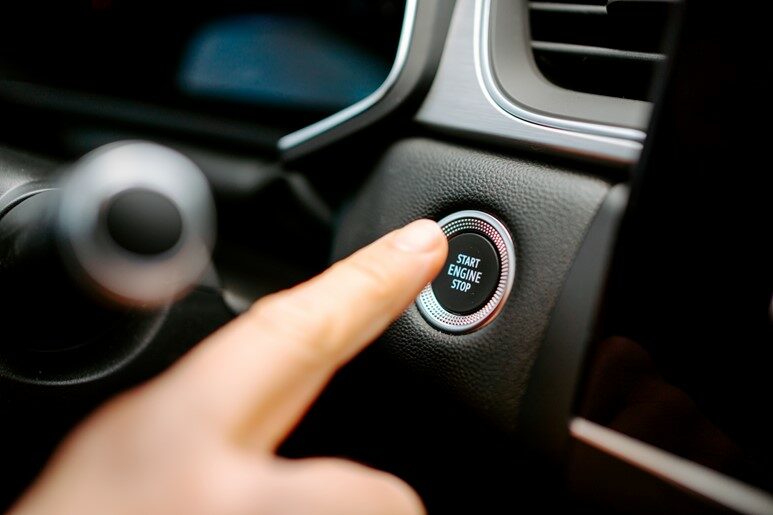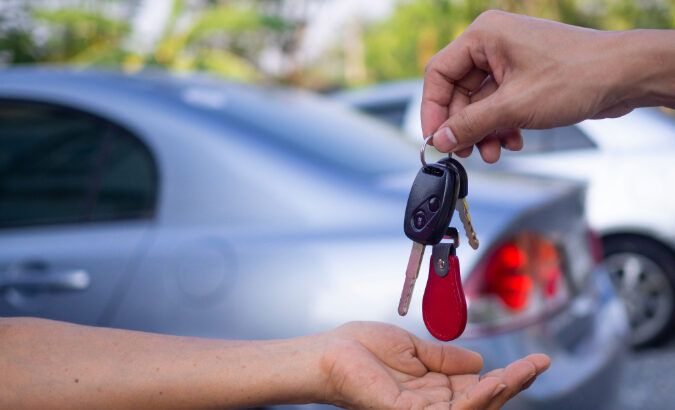
In the early 2000s, luxury car manufacturers began producing automobiles that were missing something: a key.
Like many features that first appeared in luxury autos, the dash-mounted push-button start has now filtered down to more affordable models, and its popularity continues to rise. According to figures released by the National Highway Traffic Safety Administration (NHTSA), only 5,000 cars were made with these keyless starts in 2002; it’s estimated that 90% of new cars on the market today are listed with a keyless fob. [1]
While it makes starting the car a simpler process, the system behind the button is rather complicated.
How do push-to-start systems work?
Push-button-start cars use a keyless ignition system. While the systems differ from one model to the next, they’re similar in that they replace the traditional metal key with a key fob. The fob must be inside the car for the car’s computer system to be able to connect with it, allowing the driver to start the car simply by pushing a button.
The key fob is essentially a transmitter that sends a low-frequency signal to the car. This ID signal is unique to that vehicle; once the fob is inside the car and you press the button, the car’s receiver picks up the signal and sends power to start the engine.
In addition to convenience, keyless entry was also rolled out with an eye toward decreasing auto thefts. Because the car will recognize the signal from only that one fob, it makes stealing your car more difficult. As a safety measure, the car must be in park and the driver’s foot must be on the brake for the car to start. [2]
How to push-button start a car
As long as your key fob is on or about your person, the door will unlock as soon as you press the button on the handle one time.
- Press the button on the handle twice in a row to unlock all the doors.
- Once you’re in the car, press the brake with your foot and press the engine start button at the same time. Just like that, your car will start without your having to dig for the keys.
- Once you’ve arrived at your destination, put your car in park and press the engine stop button to turn the car off. [3]
The majority of automakers include a physical key in the key fob if your need to start your car manually. There’s no standard place to find your car’s backup key slot, so check your owner’s manual ahead of time to have a plan if your fob ever dies. When you find the emergency key slot, insert your fob’s key and step on the brakes. You can then push your car’s start button as you usually would. [3]
Pros and cons of push-button-start in cars
As with all new forms of technology, there are benefits and pitfalls to adopting keyless-start cars. Although the latest iteration didn’t emerge until the early 2000s, push-button-start cars first appeared back in 1912 when Cadillac introduced an electric push-button starter to replace the risky and hard-to-operate hand crank. But then keys came along and replaced the start buttons, which typically were located on the floor or dashboard. [4]
What’s different in the modern push-to-start, of course, is the technology. While that’s what makes it more sophisticated and easier to use, it’s also what has caused concern for some drivers and industry watchers. We’ve included some of the arguments for and against push-button starters.
Advantages of push-button start in cars
- The smart key can remain in the driver’s pocket or purse when locking, unlocking and starting the car because sensors in the car communicate directly with the fob.
- The technology allows the convenience of a remote start for car owners, which can be a great way to warm up the car while it’s still locked and parked in one’s driveway.
- The technology will detect whether the key is inside the car — which makes it almost impossible to lock your keys inside your car.
- Some systems prevent you from locking your key fob inside the car with an alarm that’s triggered when the key fob gets abandoned inside your car.
- Push-button-start fobs reduce the chances of car accidents because your engine won’t start until you put your foot on the brake. [5]
Disadvantages of push-button start in cars
- Lost fobs are much more expensive to replace than traditional keys.
- Some drivers haven’t been properly educated on how to turn off vehicles with push-button ignitions, leading to people forgetting to turn them off and leaving the car running or putting them in “park” before exiting the car.
- If a fob’s battery dies, the driver will need to know how to override the system and find/use the hard key the manufacturer has hidden in the device — or call roadside assistance. [5]
Can you jump-start a keyless ignition car?
If your car battery dies, you’ll need to jump it just like a car with a regular key. You can jump it by connecting a jump box, which is essentially a small car battery with a set of jumper cables attached, to your car’s battery. Then, get into your car with your keyless fob and press the start button. [6]
Is a push-to-start car right for me?
If convenience and ease of technology are what you’re looking for in a car, a push-to-start car might be right for you. As with most technology and advancements in the auto industry, you can find things to love – and to not love – about keyless ignition systems. But as they become industry standard, it’s important for every driver to learn how to use them properly. Learn more about automotive technologies that are transforming driving.
Protect your vehicle
Choosing the right vehicle for yourself can be a difficult decision. However, one thing is for sure: no matter what vehicle you decide to drive, you’ll need the right car insurance to help give you peace of mind while you’re on the road.
Sources:
[3] “Quick Tip Tuesday: Keyless Open & Start,” markquartmotors.com/blogs/325/chevrolet/quick-tip-tuesday-keyless-open-start (May 29, 2018).
[4] “What was the first car with AC?” interviewarea.com/faq/what-was-the-first-car-with-ac (accessed on Aug. 18, 2022).
[6] “Jump start car techniques for push to start cars,” knowhow.napaonline.com/jump-start-car-techniques-push-start-cars (Oct. 6, 2016).
Disclaimer:
The information included here is designed for informational purposes only. It is not legal, tax, financial or any other sort of advice, nor is it a substitute for such advice. The information may not apply to your specific situation. We have tried to make sure the information is accurate, but it could be outdated or even inaccurate in parts. It is the reader’s responsibility to comply with any applicable local, state or federal regulations. Nationwide Mutual Insurance Company, its affiliates and their employees make no warranties about the information nor guarantee of results, and they assume no liability in connection with the information provided. Nationwide and the Nationwide N and Eagle are service marks of Nationwide Mutual Insurance Company. © 2022 Nationwide



